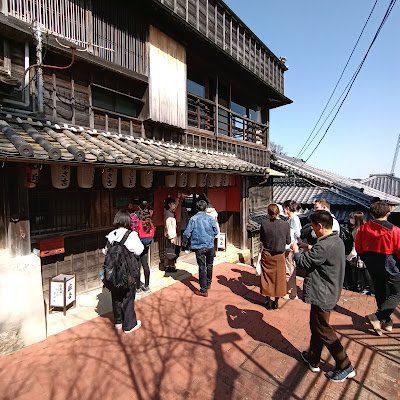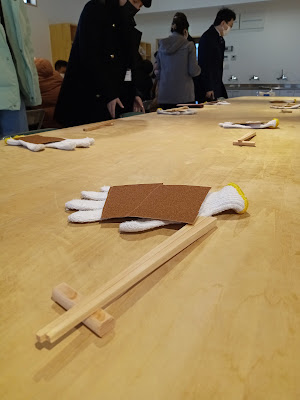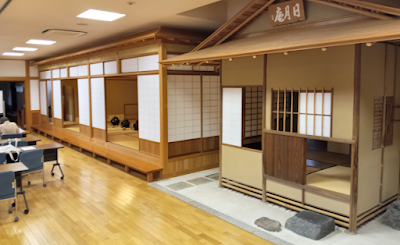Day 15, the final few lectures of the study program - customs of Ise & routes taken here in the past
 |
| Learning about the pilgrim hostel and ryokan, Asakichi |
After lunch we went to three locations connected to the Edo period and later pilgrimages. This photo shows the last old-style inn for pilgrims along the Sangu Kaido route that connects the Outer and Inner Shrines of the Ise Jingu. After 200 years and various extensions and refurbishing, the Asakichi still offers food and lodging to guests. While the remaining guest houses, theaters, eateries, and pleasure quarters tightly packed along the narrow road burned from WWII bombardment, Asaki escaped because it is offset more than 50m from there. A short walk from the hostel is located the history center (Ise Sangu Kaido shiryokan) that tells the stories of people who lived and worked along the connector route between the shrines, as well as those who traveled there from far away. The man who met us gave us an overview of the lively scenes during the heyday of the street's life.
 |
| UTAGAWA Hiroshige (1855) Ise Pilgrimage scene on display at the Ise Sangu Kaido shiryokan |
Although by now there is no one living who personally knew the performers and the events from that time, he felt strongly the value of introducing visitors and residents to those times and the meaningful things then. One of those elements is the story of the local medicine maker, Mankintan (萬金丹), whose remedies for digestion troubles was a souvenir most prized by pilgrims wanting medicine and something easy to carry on the long journey back home. The owner said the house dates to the first years of the Meiji Period which began in 1867 and that he himself can remember the business of producing and selling the herbal medicine when still a boy, so maybe 60 years before 2023, sometime in the 1960s.
 |
| near the NTT office of central Ise - 萬金丹 medicines |
Today was a good way to wrap up most of the "Ise and Japan Study Program" seminar, since so much of the Ise city and Ise Jingu story involves travel to and from this place by people from many directions. Local customs arose such as the ones highlighted in the first lecture, and the pilgrimage brought together people and ideas from distant places, not only to benefit Ise-area people, but also those travelers who learned things from other travelers, too. Seeing some of the physical traces of those earlier times, as well as the modern city's people today gives us food for thought as we get ready to summarize some of the subjects during the seminar that stand out to each of us.



Comments
Post a Comment